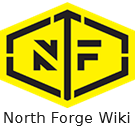More actions
John Hache (talk | contribs) m Formatting? |
John Hache (talk | contribs) m Grammar (active voice) and formatting Tags: Mobile edit Mobile web edit |
||
| Line 1: | Line 1: | ||
=== | == Safety == | ||
DANGER: FIRE. The ShopBot vacuum and dust extractor make it difficult to | ===Fire Notice=== | ||
DANGER: FIRE. The ShopBot vacuum and dust extractor make it difficult to notice a fire until it has already started spreading. Always carefully plan cuts and monitor jobs closely. | |||
If you notice any of the following: | If you notice any of the following: | ||
| Line 14: | Line 15: | ||
=== '''PPE''' === | === '''PPE''' === | ||
Wear: | |||
*Safety Glasses (to protect against flying dust and debris). | |||
Respiratory Protection (N95 dust mask or respirator) | *Hearing protection (to protect against noise greater than 85 dBa). | ||
*Respiratory Protection (N95 dust mask or respirator) to protect against airborne dust when cleaning or running the equipment. | |||
=== '''Hazards''' === | === '''Hazards''' === | ||
| Line 76: | Line 79: | ||
=== Housekeeping === | === Housekeeping === | ||
Empty the dust collector when the dust has piled halfway up the viewing window. | |||
Break down large pieces before putting them garbage bins. Blunt sharp corners to avoid puncturing the bag and injuring the person carrying it. | |||
After use, clean the equipment and surrounding area: | After use, clean the equipment and surrounding area: | ||
# While wearing respiratory protection, use compressed air to clean the gantry. Focus on areas where | # While wearing respiratory protection, use compressed air to clean the gantry. Focus on areas where parts interact: rack and pinion, spindle mount, motor mounts, etc. | ||
# Clean the floor using a broom and dustpan, shop vacuum, or the dust collector hose. Replace the dust collector hose when done. | # Clean the floor using a broom and dustpan, shop vacuum, or the dust collector hose. Replace the dust collector hose when done. | ||
# Empty any garbage bins that are more than 75% full and replace the bag. | # Empty any garbage bins that are more than 75% full and replace the bag. | ||
| Line 91: | Line 94: | ||
#* Collet wrench placed beside locking fixture | #* Collet wrench placed beside locking fixture | ||
#* Calipers, drills/impact drivers, squares, hand tools in the tool room | #* Calipers, drills/impact drivers, squares, hand tools in the tool room | ||
# Remove any personal tools, materials, and removable media from the room. The workbench should only have the wrench and locking fixture on it when done. | # Remove any personal tools, materials, and removable media from the room. The workbench should only have the wrench and locking fixture on it when done. Due to local fire code, do not store stock materials in the CNC room (fixtures are OK - label with name and phone number) | ||
# Turn off the equipment per shutdown procedures. | # Turn off the equipment per shutdown procedures. | ||
# Turn off the dust collector. If you are the last one in the room, turn off the room exhaust. The room exhaust is interlocked to the electrical system; turning off the room exhaust will turn off all equipment in the room. | # Turn off the dust collector. If you are the last one in the room, turn off the room exhaust. The room exhaust is interlocked to the electrical system; turning off the room exhaust will turn off all equipment in the room. | ||
| Line 102: | Line 105: | ||
Always measure stock thickness with calipers, never with tape measures or nominal dimensions. | Always measure stock thickness with calipers, never with tape measures or nominal dimensions. | ||
If your cut penetrates deeper than 0. | If your cut penetrates deeper than 0.06” into the spoilboard, please stop and investigate. If the stock is set up correctly and the depth of cut is appropriate, the collet may be dirty or damaged and the tool slipping out, or the secondary spoilboard may not be perfectly parallel to the gantry (for example due to debris between the primary and secondary spoilboard). | ||
==== '''SCREWS''' ==== | ==== '''SCREWS''' ==== | ||
When using North Forge’s ''secondary'' spoilboard, it is okay to screw the workpiece in place. Do not screw into the main vacuum | When using North Forge’s ''secondary'' spoilboard, it is okay to screw the workpiece in place. Do not screw into the main vacuum spoilboard. Do not use excessively long screws (ie long enough to pierce both the secondary spoilboard and the vacuum spoilboard). | ||
==== '''SPRAY ADHESIVE METHOD''' ==== | ==== '''SPRAY ADHESIVE METHOD''' ==== | ||
| Line 113: | Line 116: | ||
# Spray both surfaces with spray adhesive. | # Spray both surfaces with spray adhesive. | ||
# Press the two surfaces firmly together and hold for 30 seconds. | # Press the two surfaces firmly together and hold for 30 seconds. | ||
# Test the hold by | # Test the hold by trying to move the workpiece sideways. | ||
==== Other ==== | ==== Other ==== | ||
